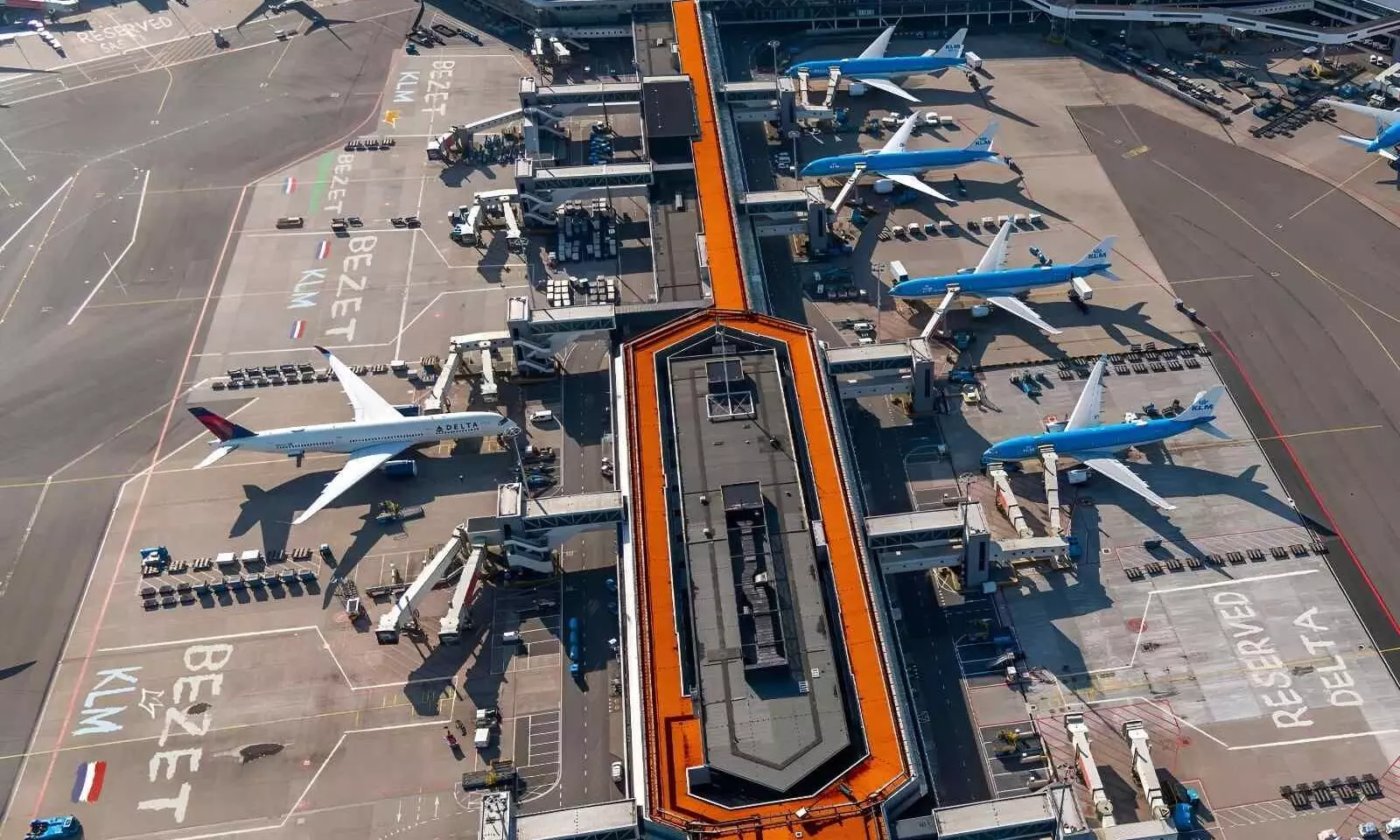
The strategic role of airports in the supply chain
Airports are now critical to global supply chains — a reality underscored by the recent cargo closure at Heathrow.

PHOTO: Amsterdam Airport Schiphol
In March 2025, Heathrow Airport—Europe’s second-busiest air cargo hub—was brought to a standstill for almost 20 hours. A fire at a nearby electrical substation triggered a cascading power failure, disabling cargo handling systems, warehouse refrigeration, customs clearance, and freighter operations across Terminals 3 and 4. Commercial passenger traffic struggled to continue on backup systems, while cargo operations came to a complete halt.
Freighters were rerouted to alternate gateways like East Midlands, Amsterdam, and Frankfurt, but many temperature-sensitive shipments and just-in-time e-commerce parcels faced significant delays and disruption. Cold chain cargo, including pharmaceuticals and fresh produce, was especially impacted as handlers struggled to find contingency storage and transport options.
The Heathrow incident once again exposed a stark reality: airports are now mission-critical nodes in the global supply chain—and their failure can paralyse entire logistics flows. This wasn’t just about one airport going dark. It was a moment of reckoning for global cargo infrastructure, digital redundancy, and supply chain resilience.
As international freight continues to grow in complexity, airports around the world are stepping up to play new roles—not just as transit points but as integrated, data-driven logistics ecosystems.
Heathrow's closure exposes a deeper truth: airports aren’t just infrastructure—they’re critical enablers of logistics continuity.
Airports as end-to-end cargo facilitators
The old "land-and-go" model of cargo transfer—where aircraft would simply land, unload or load goods quickly, and take off again—no longer holds up in today’s logistics landscape. Modern supply chains are far more intricate and demand much more from airports than just a runway. Today, airports are logistics hubs in their own right, connecting air with road, rail, and even sea freight.
Marco van Katwijk, Cargonaut
At Amsterdam Schiphol, Cargonaut, the Cargo Community Information Platform, integrates digital slots, bonded zone access, and real-time customs coordination to reduce dwell times.
“Cargonaut builds our digital resilience as our in-house port community system drives integration across all stakeholders and increases our ability to facilitate streamlined and efficient air logistics operations,” noted Marco van Katwijk, Manager at Cargonaut.
Warehouses are now equipped with automated racking, robotic ULD handlers, and dynamic storage allocation, optimising space and time.
E-commerce and express cargo boom
Airports have become the backbone of e-commerce logistics, handling high-frequency, low-weight, time-critical cargo. Major players like Amazon Air, DHL Express, UPS, and FedEx have established dedicated airside hubs at strategic locations worldwide.
At Liège Airport (LGG), night-time operations cater specifically to e-commerce, with 24/7 customs clearance. Torsten Wefers, VP Sales and Marketing at Liege Airport, stated, "Liege Airport plays a pivotal role in absorbing and adapting to supply chain shocks. Our 24/7 operations, ample free airside and landside capacities, and lack of slot constraints allow us to reroute and scale swiftly—whether due to geopolitical disruptions, pandemics, or natural disasters."
Many airports are now building express cargo terminals—streamlined facilities with integrated sorters, handheld scanners, and automated customs interfaces.
Bengaluru’s Kempegowda International Airport has the capacity to handle up to 715,000 metric tonnes of cargo annually. In CY 2024, it registered its highest-ever cargo throughput at 496,227 metric tonnes—reflecting a 17% growth over 2023. The airport is currently served by 12 dedicated freighter airlines.
“Strategic collaborations with global integrators like DHL, FedEx, and Amazon have been pivotal,” said Satyaki Raghunath, Chief Operating Officer at Bengaluru Airport. “Today, BLR functions as a vital hub for intra-Asia and pan-India express services. Our integrator-friendly ecosystem enables real-time coordination, seamless warehousing integration, and predictable transit times even during surge periods.”
Pharma, Perishables, and Cold Chain
Pharma and perishables are the most demanding cargo types, and airports are stepping up with precision temperature control and visibility.
Katwijk noted, “Almost 25% of Schiphol’s annual cargo volume is cool chain cargo. All shipments that need to be handled within a controlled temperature environment are benefitting from sensors and/or GPS monitoring systems, specialised cool boxes, containers and trucks when required, all under close management supervision to safeguard the logistics integrity from end to end.”
"Our 24/7 operations, ample free airside and landside capacities, and lack of slot constraints allow us to reroute and scale swiftly—whether due to geopolitical disruptions, pandemics, or natural disasters."
Torsten Wefers, Liege Airport
Hactl’s Cool Chain Complex (CCC) at Hong Kong International Airport (HKIA) plays a crucial role in the global cold chain, particularly for pharmaceuticals, perishables, and other temperature-sensitive goods.
Wilson Kwong, CEO of Hactl, stated, "The CCC provides a seamless handling process for temperature-controlled shipments. It is the largest facility of its kind at HKIA and the first to feature a dedicated climate-controlled area for storing dangerous substances. CEIV Fresh-certified, the CCC addresses the specific needs of perishable cargo with cutting-edge temperature control and monitoring systems."
In India, BLR Airport is home to India’s first integrated on-airport Perishable Cargo Handling Centre, the "WFS BLR Coolport", a state-of-the-art facility designed to meet the growing demands of temperature-sensitive cargo. This new facility strengthens India’s position as a global hub for pharmaceuticals and perishables. As Raghunath, highlighted, "BLR Airport is India’s top airport for perishable exports. Our GDP-certified cold chain infrastructure and temperature-controlled handling ensure safe, compliant movement of pharmaceuticals and perishables, supporting India’s position as a global pharma powerhouse.”
Hyderabad Airport (HYD)—a key pharma export hub—offers automated temperature validation, thermal insulation, and a real-time monitoring dashboard for shippers. Pharmaceuticals make up over 70% of Hyderabad’s exports, underscoring the city’s role as a major hub for pharmaceutical manufacturing.
Satyaki Raghunath, Bengaluru Airport
“LGG supports diverse cargo types through dedicated infrastructure—climate-controlled pharma hubs, live animal centres, and express freight terminals,” said Wefers. “By leveraging digital cargo tracking and modular warehousing, we maintain high throughput and tailor operations to fit each cargo profile.”
Fresh produce exports from around the world are also enabled by fast-track perishables terminals with tailored storage for flowers, seafood, meat, etc.
Smart Cargo Airports of the Future
As airports evolve into intelligent trade hubs, the cargo terminal of the future is shaping up to be self-optimising, digitally connected, and platform-driven. At its core, it will be AI-powered yard planning tools designed to reduce truck and container dwell times, cutting congestion at peak hours.
Blockchain could play a pivotal role in securing e-AWBs and speeding up customs clearance, improving both traceability and compliance. Cutting-edge infrastructure will support high-frequency, short-distance shipments with minimal turnaround. Predictive analytics will tie it all together, offering the ability to forecast cargo congestion and reroute shipments dynamically, ultimately transforming the way global cargo moves through the air.
Wefers stated, “Looking ahead, the next evolution in airport-driven supply chain innovation will centre around automation, AI-driven logistics, green infrastructure, and increased data transparency across the cargo journey. At LGG, we are investing in smart cargo operations, digital twin technologies, and sustainability projects like carbon-neutral cargo zones. Airports like LGG that embrace tech innovation, circular economy principles, and collaborative ecosystems will define the future of global logistics.”
Airports aren’t just runways anymore—they’re invisible engines of commerce in the global supply chain, orchestrating cargo flows across continents with precision, speed, and resilience.
The article was originally published in the May 2025 issue of The STAT Trade Times.

